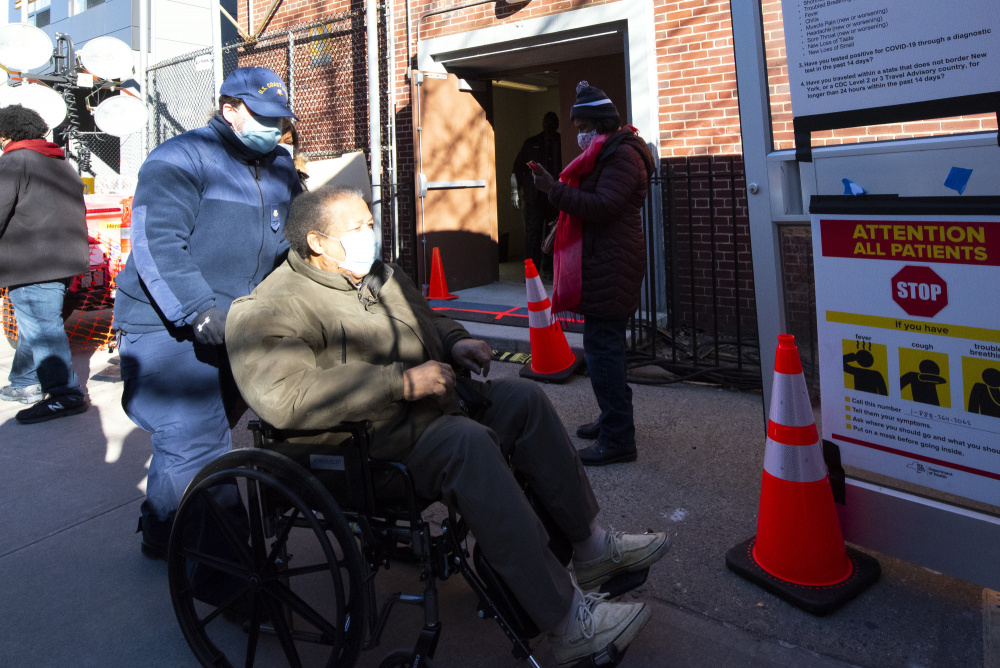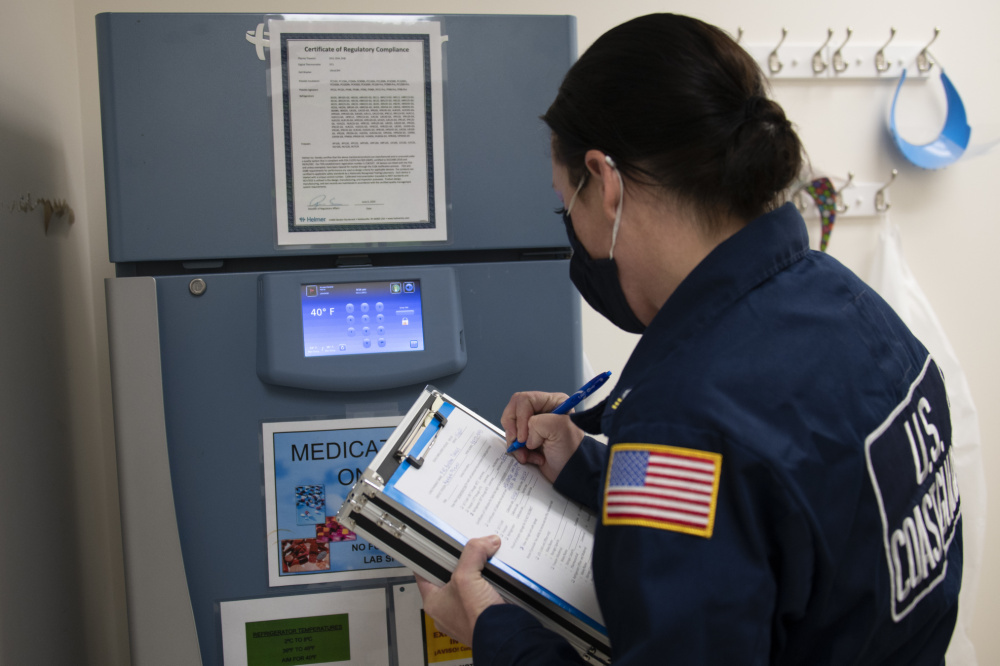Over the last year, the Coast Guard and Coast Guard reserve have seen a pandemic-related surge in operations at all levels of the organization, bringing on people to support by adjusting policies, augmenting a strained or quarantined active duty crew, or, most recently, working with the Department of Health and Human Services on interagency operational coordination.
In February, the Coast Guard Reserve was called upon in a different way to directly support the national vaccination effort at federally supported community vaccination centers around the country.
“So far we have sent about 100 reservists on Title 10 orders to support vaccination centers across several states in response to FEMA mission assignments,” said Capt. Craig Wennet, a member of the Office of Emergency Management and Disaster Response at Coast Guard Headquarters assigned to the COVID Crisis Action Team to coordinate the involuntary recall.
Weighing the requested need against the Coast Guard’s available bandwidth, the service pulled together teams of co-located personnel, rather than sending individual reservists. The members are currently supporting vaccination center efforts in Oklahoma City, New York, Dallas, Oakland California., and Portland, Oregon.
New York
In New York, 20 reservists, most from Sector New York and Sector Long Island Sound, in New Haven, Conn., reported to two community vaccination centers in Brooklyn and Queens, New York. The sites are state-run and federally-supported, with FEMA as the lead agency.
Lt. Cmdr. Jeff Brodeur of Sector LIS Enforcement volunteered to leave his job as a communication and outreach specialist; he reported to the site in Queens in late February.
"I talked to my wife and my kids, and I said, ˜This might be a way for me to make a difference,'" Brodeur said. "Things moved fast, we got orders on a Thursday to report by noon Friday, and when we walked in the door of the facility, [FEMA and the Navy] were happy to see us. Typical Coasties, we jumped right in."
The first week, the team saw 14-hour, adrenaline-fueled days, but they soon settled into a rhythm. Working seven days a week was tough, but they appreciated the kindness and gratitude from the community.
the kindness and gratitude from the community.
“This was a very hard-hit area a year ago,” said Brodeur. “People have been telling us about family members who were impacted, and they see this as perhaps a little light at the end of a very long and dark tunnel.”
The centers stayed open from 8 a.m. to 8 p.m., but lines formed outside by 6 a.m., and a steady pace of community members flowed in at a rate of 3,000 per day.
Senior Chief Petty Officer Jeff Ray, the senior enlisted reserve advisor for Station New London, Conn., and deputy team leader for the Coast Guard members, reminded the team to pace themselves as they conducted mostly outdoor effort crowd control, intake measures, traffic management, and wheelchair assistance, especially in cold weather.
"We’re often reminded that it's a marathon, not a sprint," Brodeur said about the effort, which inoculated more than 80,000 between the two sites in the first three weeks. “As Coast Guard members, we’ve told ourselves that while it's not a 45[-foot response boat] or a helicopter, we're still saving lives, one recipient at a time."
Oklahoma City
Each of the locations is managed, staffed, and employed in different ways. In Oklahoma City, deployed Coast Guard reservists experienced a different setup and localized need.
Ensign Tom Coleman, a 14-year mustang from Sector Ohio Valley, got the call for his first deployment as an officer, leading a team of six, the majority of whom were from
Sector Mobile, Alabama.
As a program manager for a product engineering department, he made a few quick phone calls and reported to the site in Oklahoma City within 36 hours. Coleman and his team, with over 90 years of Coast Guard experience among them, worked with the Oklahoma State Department of Health (immunizations division) to identify the needs of the state and how the team could best support.
“My team is very seasoned, highly motivated and wants to help out,” said Coleman.
“They work with the DoH to assess sites of potential vaccine providers throughout the state. Pairs of Coast Guardsmen travel to distances a few hours away to run through a checklist. It’s a good thing we’re central; we can get to anywhere in the state within about three hours. We make sure they have all the proper equipment: refrigeration, temperature control devices, and documentation,” said Coleman. “If we find that a site does not meet requirements per CDC guidelines, we work with them to get them up to speed.”
On the weekends, the team works shifts at POD (point of distribution) events where they help facilitate day-long vaccination efforts at places like convention centers, local college campuses or local arenas.
“We help with anything from registering vaccine recipients to directing traffic, preventing any log jams in the process,” said Coleman.
He said people are occasionally surprised to see the blue suits as part of the clinics. The team ended up contacting the local Coast Guard recruiting office to make use of the unit’s workstations occasionally, and he was given a few business cards to hand out on his travels.
“There’s not a huge Coast Guard presence in Oklahoma,”said Coleman, “but we’re out making relationships all over the state.”
Dallas
Down in Dallas, Lt. j.g. Brandon Towle, a reservist at the Incident Management Division in Sector Corpus Christi, Texas, arrived at the county site Feb. 25 with a few members from his team of 12. Taking a different tack, Towle and Ensign Rex Anderson visited the site to meet with the incident commander and identify roles and responsibilities.
“Some of our guys are law enforcement officers, one guy owns his own logistics company,” said Towle. “They bring their own unique capabilities.”
Many of the members had volunteered to deploy, Towle said, but identifying the capabilities of the Coast Guardsmen before slotting them in roles was helpful to maximize the team’s performance, effectiveness, and enthusiasm for a mission that will likely go longer than 60 days.
“You play the long game,” said Towle.
Petty Officer 1st Class Joseph Garza, a reservist and maritime enforcement specialist for Sector Corpus Christi, said he reported to the site with only a few days-notice. He gave notice to the San Antonio Police Department, organized his family obligations, and got to work with his team—many of whom he’d spent years working with at the Sector.
“It was extremely beneficial to know the individuals from the same section,” said Garza. “You already have that relationship there; you know their work ethic, you have that comfort level.”
The team hit the ground running hard for two weeks, but after being on their feet for 10 to 12 hours per day, they quickly realized the pace was unsustainable.
Using the system of cross-training and a six-day duty schedule, the team increased their endurance without losing coverage of their collective responsibilities. Through cross-training, the members rotated into designated roles, duties or
ICS responsibilities where they became involved with logistics, planning, site safety, traffic management, medical help, and resource management.
“We’ve established great relationships,” Garza said. “When we put the right people in the right areas, our numbers changed immediately.”
The site averages 7,000 doses per day, said Garza, but with the efficiencies helped by the Coast Guard team, the site has seen days where the staff has administered more than 9,000 doses.
Towle said the county site is running smoothly, with participation from many agencies including FEMA, DoD, state and county officials, and members of private health care industry.
“We had a few hiccups at the beginning, as normal, which is to be expected,” said Garza. The Coast Guard prepares us for this in that they teach us to maintain flexibility. Here, everyone knows the common goal, the common objective at the end of the day.”
“The chemistry between the agencies is great,” Towle said. “There are no egos with the folks working at the site; the goal is injections.”
Oakland
The largest group of reservists, a team of 40, works at the vaccination site in Oakland. Patients are brought in via mass transit, go through a three-tent system (admin, vaccination, monitoring), and return to the city via mass transit. The all-reserve member team of Coast Guardsmen staff the first tent, greeting patients as they step off the train or bus for their vaccination appointments and checking them into the system administratively.
Capt. Frank Schaefer is normally the Pacific Area’s Reserve Chief of Staff, but in April 2020, he was brought on Title 10 orders to serve as the area commander for PACAREA’s COVID-19 area command.
In early March, he paid a visit to the site, along with PACAREA Commander Vice Adm. Linda Fagan, several other admirals and two command master chiefs. The VIPs toured the area and spoke with the first responders.
“It was truly an eye-opening experience to see the sheer magnitude of the effort, not only from our federal and state partners, but also the 40 members of the Coast Guard Reserve.”
Schaefer said the flow of people, most of whom have conditions that fall into the high-risk category, is more than 10,000 per day. The majority of reservists are helping the flow of foot traffic through the vaccination site, but some are filling planning and logistics roles as well.
“It’s really impressive to see the level of professionalism and pride that our Coast Guard reservists are exhibiting in the performance of a mission outside the scope of normal Coast Guard reserve missions. They bring a unique perspective of being able to work with and be part of an interagency team.”
Schaefer said they tried to look locally within D11 to fill Oakland’s personnel request before employing reservists from outside the area.
“There’s a genuine appreciation when you give back to the local community during a major contingency response,” said Schaefer. “When you’re helping your neighbors, it’s felt not just by the members but also by those being helped as well.”
Schaefer said he’s got an additional 16 reservists going to a new vaccination site in Portland in mid-March, and a few more slated for other locations.
This article is courtesy of Reservist Magazine, the official monthly publication of the Coast Guard Reserve. To read the latest issue and archived content, visit their website. Learn more about opportunities to serve as a reservist here.